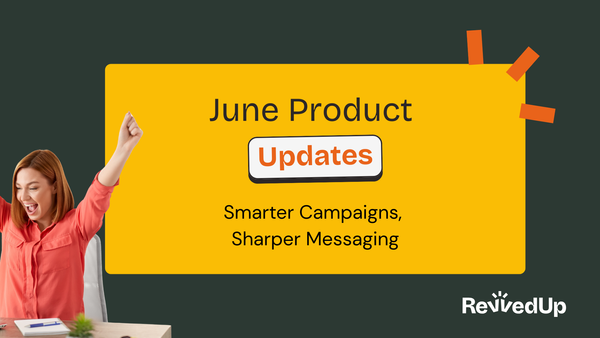How to Use Micro-Events to Build Community (and Pipeline)

Micro-events are one of the highest-impact plays in modern go-to-market strategy. Whether you're nurturing future customers, accelerating open deals, or deepening relationships with existing ones, the right micro-event can drive pipeline, unlock insight, and create serious brand momentum.
Micro-events are one of the highest-impact plays in modern go-to-market strategy.
Whether you're nurturing future customers, accelerating open deals, or deepening relationships with existing ones, the right micro-event can drive pipeline, unlock insight, and create serious brand momentum.
In our recent RevvedUp webinar, we brought together a powerhouse panel—Nicola Anderson (CMO Circle), Kartik Krishnan (Expedite GTM), and Katie McPhee (Upwards)—to unpack exactly how B2B teams are using small-format events to punch above their weight.
Here’s a practical breakdown of the key takeaways.
Why Micro-Events Are Having a Moment
In a world where email open rates are falling and everyone’s inbox is flooded with cold pitches, small, curated events offer something rare: attention.
“Digital is getting noisier and less effective,” said Kartik. “Micro-events let you handpick the right people, create a moment of value, and build trust at scale—but without the spray-and-pray approach.”
They’re not new. But what’s changed is how B2B teams are integrating them directly into ABM and outbound strategies—with a clear eye on ROI.
When (and Where) They Work Best
One of the biggest misconceptions is that micro-events are only useful at the top of the funnel. The panel strongly disagreed.
“They’re powerful across the full journey,” said Nicola. “It’s just about choosing the right format and intention.”
- Top of Funnel (TOFU): Panel talks, virtual roundtables or community breakfasts to explore the problem space. These should be low-commitment, value-first and idea-led. Katie used micro-events to build trust for a startup in an emerging category: “It helped build credibility and category awareness before the solution was fully understood.”
- Mid-Funnel (MOFU): Invite current customers to share stories. Drinks with a mixture of current customers and early-stage prospects can be a great way to nurture a wider pipeline of leads without blowing the budget.
- Bottom of Funnel (BOFU): Dinners or invite-only roundtables where late-stage prospects sit beside happy customers. “You’re not pitching,” said Nicola. “You’re curating an experience that shows the kind of company you are.”
- Post-Sale: Build loyalty and unlock expansion. Customer advisory boards, private breakfasts, and regional meetups all play a role. “Some of my strongest advocates came from these,” she added.
Format: In-Person, Virtual or Hybrid?
This depends on your ICP, motion, and team capacity.
- In-person delivers unmatched relationship-building. “People remember who they had dinner with,” said Kartik. “It builds trust quickly and accelerates deals.”
- Virtual wins on scalability and inclusivity. “Some prospects just won’t come into London or New York,” Nicola noted. “Virtual lets you reach them, test ideas, and build pipeline at a lower cost.”
- Hybrid & Roadshows let you do both. Katie shared a successful pivot from a large breakfast roundtable into a CEO coffee series that became a scalable playbook.
Bonus tip: Repurpose panel discussions or Q&As into content, then use that as a hook for future events.
Getting the Right People to Show Up
This is where many teams fall short. You don’t just need RSVPs—you need the right RSVPs to convert to attendees.
Tactics that work:
- Leverage social proof. “Tell them who else is coming—even if they haven’t confirmed yet,” Nicola advised. “It creates FOMO fast.”
- Be personal. From handwritten invites to direct intros, every touchpoint matters. Katie recommended starting six weeks out, using email for consistent momentum.
- Lower friction. “We once sent Uber vouchers to decision-makers to guarantee they’d get there,” Kartik shared. “That’s pipeline insurance.”
- Piggyback on bigger events. Host your micro-event next to a major conference or trade show. “It’s a great way to get high-quality attendees who are already in-market,” he added.
Measuring Success (Beyond Show Rate)
Yes, attendance matters. But it’s not the only thing that does. You need to track the right metrics to ensure continued buy-in from senior leadership.
- Pipeline influence. “We track not just net-new leads, but acceleration, engagement, and expansion,” said Kartik. “Deals touched by events tend to close faster and bigger.”
- Qualitative feedback. What did people learn? What did they share back? What questions were asked?
- Content fuel. Katie: “The questions we heard at events shaped new marketing campaigns and messaging themes.”
- Reputation effect. Nicola suggested using NPS or review quotes to promote the next event. “It builds anticipation and credibility.”
Importantly, attribution shouldn’t be limited to last-click. “A deal that closed in Q4 might’ve started with a dinner in Q1,” Katie pointed out. “You’ve got to take the long view.”
From Event to Revenue: Nailing the Follow-Up
“If there’s no follow-up plan in place before the event, you’re already behind,” said Nicola.
Winning follow-ups share a few traits:
- Timely and personal. Reference conversations, shared interests, or specific questions. “Even a small callout like ‘you mentioned X’ makes a big difference,” said Kartik.
- Helpful, not pitchy. Katie advised thinking of follow-up as a bridge to the next experience. “What’s the next step on their journey with you?”
- Shareable assets. Whether it’s a short video, a visual summary, or attendee intros, send something of value.
- Surprise & delight. Nicola’s team once followed up with a tiny gift based on a random chat about snacks. “It cost £2. The response was huge.”
Avoid These Common Mistakes
Every panelist had war stories—here are the most frequent missteps they’ve seen:
- No clear objective. “If you don’t know what success looks like, your audience won’t either,” said Katie.
- Over-engineering. “Let people talk. Leave space for connection,” said Nicola.
- Treating events like a sales call. “Trying to force every event to be a sales touchpoint is the fastest way to kill trust,” Kartik warned.
- Skipping the prep. “Give your team a one-pager on who’s attending and why. Otherwise they’re just winging it,” said Mark.
Final Tips From the Panel
- “Start small. A six-person dinner can drive six figures in pipeline.” — Nicola
- “Be flexible. Things will go wrong. That’s okay.” — Kartik
- “Think in experiences. What happens after the event matters as much as the event itself.” — Katie
Don't be afraid to mix it up. Pub quizzes, boat rides, breakfast salons—stand out by doing it differently.
How RevvedUp Makes Micro-Events Work Harder
- Get the right people in the room. RevvedUp identifies high-fit prospects based on live signals, buyer stage, and account context—so you can invite the people who actually matter, with messaging that lands.
- Send invites that get opened. Personalised outreach at scale, referencing company news, intent triggers, and even individual job titles. No more one-size-fits-all invitations.
- Follow up like a pro (without spending hours). Whether they attended, asked a question, or no-showed, RevvedUp triggers custom follow-up sequences that reflect what the person cares about—at scale.
- One-click intelligence for your team. AEs get a quick view of who was there, what they care about, and what to say next—so they’re not wasting precious cycles guessing.
More pipeline. Less admin. Better conversion. That’s how RevvedUp plugs straight into your micro-event strategy.
Conclusion
If you’re building pipeline in B2B, micro-events should be part of your playbook. They don’t scale like ads—but they build trust, unlock insights, and create conversion moments that mass outreach simply can’t.
Plan with intention. Lead with value. Follow up with care.
In a noisy digital world, this is how you cut through.




